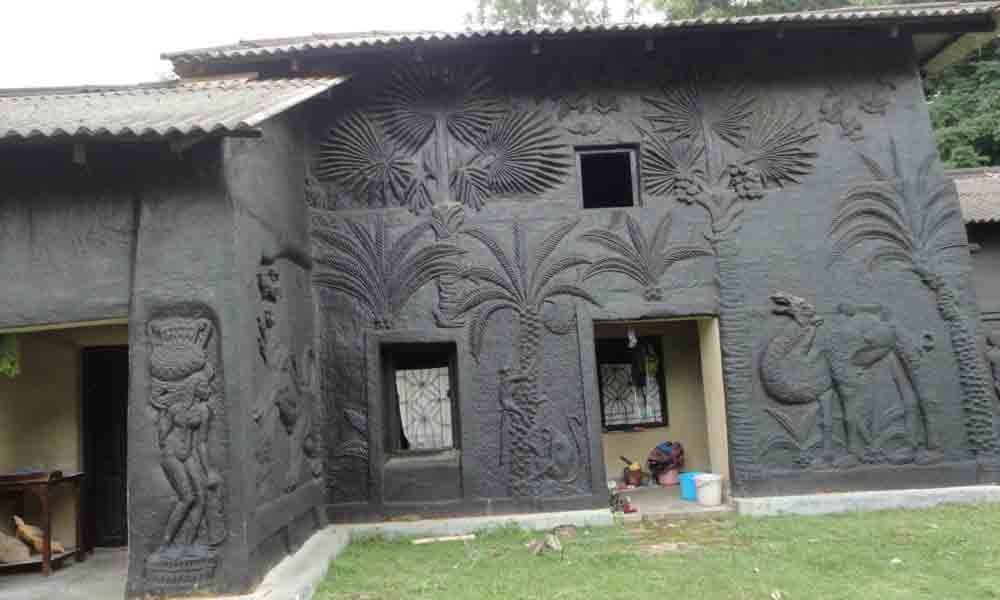In the land of Tagore
Nobel Laureate Rabindranath Tagore’s vision has transformed a small rural settlement into a unique university town – Shantiniketan. The once hub of experimental open school method of learning continues to draw visitors and educationists from all over
As our train rolled into Bolpur, we watched the sunset on the horizon against a mesmerising backdrop of lush green paddy fields fringed by bottle green forests of sal trees. A little later, as we were on a cycle rickshaw towards Shantiniketan, traversing the kutcha brick-red streets fringed by neat looking mud houses interspaced with rows of swaying palm, our driver suddenly burst into a soulful Rabindra sangeet (Song written by Rabindranath Tagore).
"Graam chara oi ranga matir poth, amar mono bhuloy re (The red street which takes off from the village, captivates my soul) Nobel Laureate Rabindranath Tagore's vision has transformed a small rural settlement into a unique university town. The once hub of experimental open school method of learning continues to draw visitors and educationists from India and all over the world. An abode of greenery and adorned with splendid sculptures, frescoes, murals, and paintings, Shantiniketan, even in the twenty-first century, has successfully retained the essence and ethos of a traditional ashram without being alienated from the world surrounding it.
Shantiniketan embodies Rabindranath Tagore's vision of a place of learning that is unfettered by religious and regional barriers. It is really a fascinating story as to how the rural paradise of Shantiniketan, Tagore's erstwhile home, became a thriving centre of art, education and internationalism over the years. In 1862, Maharishi Debendranath Tagore, father of Rabindranath, was taking a boat ride through the countryside of Bengal, when he came across a landscape that struck him as the perfect place for meditation. Captivated by the beauty of the luxuriantly canopied chhatim trees that offered shade in the rugged, red-hued terrain, he bought the large tract of land that had charmed him, built a small house and planted some saplings around it. Debendranath Tagore decided to call the place Shantiniketan, or the 'Abode of peace', because of the serenity it imparted to his soul.
In the following years, Rabindranath envisioned an education system that was deeply rooted in one's immediate surroundings but connected to the cultures of the wider world. With this in mind and established with the aim of making education go beyond the confines of the classroom, on December 22, 1901, Rabindranath Tagore established an experimental school at Shantiniketan with five students (including his eldest son) and an equal number of teachers. He originally named it Brahmacharya Ashram, in the tradition of ancient forest hermitages called 'tapoban'. Even today, school students can be seen studying under the cool shade of trees, just as Tagore had intended it to be as he wanted students should be as close to nature as possible.
Shantiniketan grew into the Visva Bharati University in 1921, attracting some of the most creative minds in the country. Tagore was not a mere dreamer; he was a visionary with the will power to translate them to reality. The guiding principle of this place is best described in Tagore's own words:
"The highest education is that which does not merely give us information but makes our life in harmony with all existence."
We began our day with a visit to Chhatimtala, the birthplace of the Santiniketan gurukul. It is a visually appealing prayer house made with Belgium glass and a marble floor built by Debendranath Tagore in 1863.
Our next stop was at the Uttarayan Complex where Udyan, Konark, Shyamali, Punasche, and Udichi- the five houses built during different phases of Rabindranath Tagore's life still stand proudly. The sixth, Bichitra, built by his son in 1961, was inaugurated by Jawaharlal Nehru. It serves as a library and museum with Tagore's manuscript, title deeds, letters, pictures and paintings besides the awards he has been decorated with at various phases in his life. Tagore's car, a black Humber was also there on display. All around us were fascinated visitors, peeping through the windows and discussing Rabindranath Tagore's life and work with great passion. This we found to be a common sight to behold anywhere and almost everywhere in Shantiniketan.
Vishva Bharati University campus, the most important place in town, opens for visitors after 1 pm. There are no guides, but some students offered to show us around. The university offers a range of courses across fields but is most famous for Sangeet Bhavan, the music department, and Kala Bhavan, the arts department. Wandering through Kala Bhavan we could witness works of some of India's most renowned artists and watch students engrossed in creating their own masterpieces.
Though the Visva Bharati University and Uttarayan Complex (where the poet and his family lived) are the main attractions, the exotic rural landscape and the peaceful countryside around the little town are no less appealing. A stroll in the Sonajhuri forest or a walk along the banks of the river Khoyai, especially on a full moon night area offer a sure cure for the stressed soul. Although much has undoubtedly changed since the times of Rabindranath Tagore, the soul and spirit of the great poet continue to live on in Shantiniketan. Even today, in every step, in every brick and in every tree at Shantiniketan, one can still feel him, his presence, his passion, his dedication and his pride in the institution. With numerous instagrammable spots, quiet bookstores, quaint cafés, colourful bazaars, sparkling rivulets and golden forests, there is a lot to do and see in this seemingly small town.









